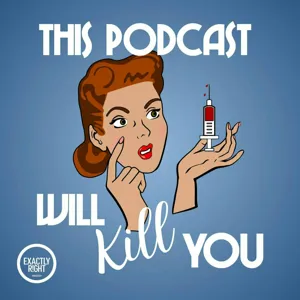Podcast Summary
James Boswell's Multiple Encounters with Gonorrhea: Gonorrhea is a sexually transmitted disease that requires medical attention and safe sex practices to prevent its spread. It can affect adults through vaginal, oral, and anal intercourse, and infants during delivery. Gonorrhea is related to meningitis-causing bacteria.
Gonorrhea is a sexually transmitted disease caused by the bacterium Neisseria gonorrhoeae. James Boswell, a biographer, contracted it multiple times throughout his life despite taking precautions. The disease can be transmitted through vaginal, oral, and anal sexual intercourse for adults, while in infants, it can be passed from mother to baby during delivery. Gonorrhea is a serious condition that requires medical attention, and it's essential to practice safe sex to prevent its spread. The discussion also mentioned that gonorrhea is closely related to another bacterium, Neisseria meningitidis, which causes meningitis. The hosts of the podcast were drinking a quarantini called "Burning Love" while discussing gonorrhea.
Gonorrhea's Protective Pili Allow Bacteria to Evade Immune System: Gonorrhea causes harmful symptoms if untreated during pregnancy. Its pili help bacteria attach, replicate, and evade immune system, making testing and treatment crucial.
Gonorrhea is a serious bacterial infection that can cause significant harm if left untreated, particularly in newborns. During pregnancy, screening and treatment are crucial to prevent neonatal infections. Once contracted, gonorrhea bacteria use pili, or long protein strands, to attach to epithelial cells in the genitourinary tract. These bacteria can replicate rapidly and even survive inside neutrophils, the body's first line of defense against infections. As a result, gonorrhea can evade the immune system and cause symptoms such as painful urination, discharge, and epididymitis (inflammation of the epididymis). Most infections are asymptomatic, making it essential to get tested and treated if exposed. The discharge from a gonorrhea infection is highly infectious and can spread easily through sexual contact.
Asymptomatic gonorrhea infections can lead to serious complications: Asymptomatic gonorrhea can lead to severe complications, including pelvic inflammatory disease, infertility, and even life-threatening infections. Regular screenings and safe sex practices are crucial for prevention.
Gonorrhea infections can be asymptomatic, especially when they affect the endocervix. This makes it difficult to detect and can lead to serious complications, such as pelvic inflammatory disease (PID), infertility, and even disseminated infections that can affect the joints, skin, and meninges. These complications can be severe and potentially life-threatening, especially in infants and those with weakened immune systems. Therefore, it's important to be aware of the potential for asymptomatic infections and to practice safe sex and regular screenings to prevent the spread of gonorrhea. While there are effective treatments for gonorrhea, prevention is always the best approach. Condoms offer some protection against the disease, and regular screenings and testing are essential for early detection and treatment. Additionally, neonatal infections can lead to blindness and disseminated infections, making it crucial to screen pregnant women and newborns to prevent these complications.
History and origins of gonorrhea: Gonorrhea is a sexually transmitted infection treated with ceftriaxone and azithromycin due to co-infections and antibiotic resistance. Its origins are unclear but date back to ancient civilizations.
If you are diagnosed with gonorrhea, you will receive an injection of ceftriaxone and a single dose of azithromycin to treat both gonorrhea and common co-infection of chlamydia. This dual treatment is necessary due to the high prevalence of co-infections and the antibiotic resistance of gonorrhea. The name "gonorrhea" comes from ancient sources, including descriptions of genital ulceration and urethral discharge in Egypt, the Bible, and Hippocrates. The Greek physician Galen gave the disease its current name in the 2nd century CE. For centuries, gonorrhea was prevalent and led to the creation of laws to prevent its spread. Its origins are unclear, but it may have evolved from a non-pathogenic strain in the vaginal or rectal mucosa or from the nasopharynx via oral sex.
Misconceptions and Mistaken Identities of Gonorrhea: Historically, gonorrhea was often confused with syphilis due to their similar symptoms and long infectivity. Various treatments, from reasonable to bizarre, were tried, but washing out the urethra became the most common method. Gonorrhea was eventually distinguished from syphilis, leading to separate cures.
The history of gonorrhea is marked by confusion and misconceptions due to its similarities with syphilis and the long duration of its infectivity. Known as the "clap" since the 1500s, gonorrhea was often mistaken for syphilis, leading to debates about their distinct identities. One infamous attempt to prove they were the same disease resulted in the researcher contracting syphilis instead. The pathophysiology of gonorrhea was also unclear, with theories suggesting it originated in women or came from nonsexual sources. Throughout history, various treatments for gonorrhea were tried, ranging from the reasonable (rest, avoid alcohol, and abstain from sex) to the bizarre (injecting mercury into the penis, using breast milk and cow's milk for urination, and applying leeches). The most common treatment eventually became washing out the urethra. Despite these challenges, gonorrhea was eventually distinguished from syphilis, leading to separate cures.
Historical gonorrhea treatments involved using bougies: Early gonorrhea treatments used invasive bougies, posing risks and often ineffective for women
Throughout history, the treatment for gonorrhea and its aftermath, known as gleet, involved the use of various instruments like bougies. These were thin, flexible rods made of materials like silver, lead, or wax, which were inserted into the urethra to help clear obstructions and improve urination. Some bougies even had corrosive crystals at their tips to erode inflammation, but they could be dangerous and even fatal. Diagnosing and treating gonorrhea in women was more challenging due to the lack of clear symptoms and the reluctance of physicians to perform vaginal exams. As a result, treatments for women were often ineffective and could lead to infertility. The history of gonorrhea treatment is a reminder of the importance of proper medical knowledge and the potential risks of invasive procedures.
Misunderstood Causes and Effects of Gonorrhea: Throughout history, gonorrhea's causes and effects were misunderstood, leading to various theories and self-experimentation. It wasn't until the late 1800s that the true cause, Neisseria gonorrhea, was discovered, but its impact on women and infants was not fully understood.
The misunderstanding and misconceptions surrounding gonorrhea's causes and effects led to various theories and self-experimentation. SwedeR's extreme self-experimentation concluded that gonorrhea was just a simple irritation of the urethra, while others believed it was female-specific or caused by predisposing factors. By the late 1800s, with the age of microbiology, the true cause of gonorrhea, Neisseria gonorrhea, was discovered by Albert Neisser. However, the impact of gonorrhea on women and infants was not well understood. Gonorrhea in infants could lead to blindness if left untreated, but it was not yet treatable. German obstetrician Carl Sigmund Franz Krede made significant contributions to understanding gonorrhea in women, revealing it as a common cause of infertility and a latent infection that could still cause infection in women. Despite these findings, the morality of American males was attacked, hindering the acceptance of these conclusions.
History of treating gonorrhea: A long struggle against antibiotic resistance: Despite the identification of the bacterium causing gonorrhea and the development of antibiotics, the disease remains a major public health concern due to the rapid emergence of antibiotic-resistant strains. An estimated 820,000 new infections occur annually in the US, and 78 million new cases are estimated globally.
The history of treating gonorrhea involves a long and ongoing struggle against antibiotic resistance. Starting in the 1800s, doctors like Krede tried various methods to prevent eye infections in newborns caused by their mothers' gonorrhea. Eventually, the use of silver nitrate was effective. However, even as the causative bacterium was identified in the late 1800s and antibiotics were developed in the mid-1900s, gonorrhea continued to be a major health issue due to the rapid emergence of resistant strains. This trend has continued, with super bug strains causing concern today. In the US, an estimated 820,000 new gonorrhea infections occur each year, with 555,000 reported cases in 2017. Worldwide, 78 million new infections are estimated annually. The prevalence of gonorrhea increased significantly in the mid-1900s due to changing sexual practices and the availability of contraceptives, and it continues to be a major public health concern due to the ongoing issue of antibiotic resistance.
Growing concern of antibiotic resistance in gonorrhea: Despite the importance of regular screening for gonorrhea due to high rates of asymptomatic infections, antibiotic resistance is a major challenge, with Neisseria gonorrhoeae developing resistance through various mechanisms. Few new drugs are in development, highlighting the need for continued research and public health efforts.
Gonorrhea is a common sexually transmitted infection (STI) with high rates of asymptomatic infections, making regular screening important. However, antibiotic resistance is a major concern, with reported resistance to all major classes of drugs used to treat gonorrhea in numerous countries. Neisseria gonorrhoeae, the bacterium causing gonorrhea, is particularly adept at developing resistance through various mechanisms, including altering cell membranes, inactivating drugs, and transferring antibiotic-resistant genes between bacteria. Currently, only a few new drugs are in development to combat resistant gonorrhea, emphasizing the need for continued research and public health efforts to address this growing issue.
Challenges in combating gonorrhea with antibiotics and developing a vaccine: Despite ongoing research, antibiotics to combat gonorrhea are uncertain, and a vaccine is not expected soon. Practice safe sex and regular testing to prevent and manage infections.
While there are antibiotics being developed to combat gonorrhea, their progress is uncertain. Additionally, the development of a gonorrhea vaccine has proven to be a significant challenge due to the bacterium's ability to evade the immune system and resist first-line defenses with its massive antigenic variation. Despite ongoing research, a vaccine is not expected to be available in the near future. It's important to continue practicing safe sex and getting regular testing to prevent and manage gonorrhea infections. The book "The Scars of Venus" by JD Oriole, the Cambridge World History of Human Disease edited by Kenneth Kippel, and various research papers were referenced in this discussion. Stay tuned for more episodes on various diseases and their histories. Remember, this podcast will kill you... in a good way! (Sources will be posted on our website.)





 In this Episode we talk to guest Jenelle Marie Pierce from The STD Project
In this Episode we talk to guest Jenelle Marie Pierce from The STD Project